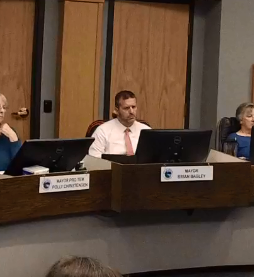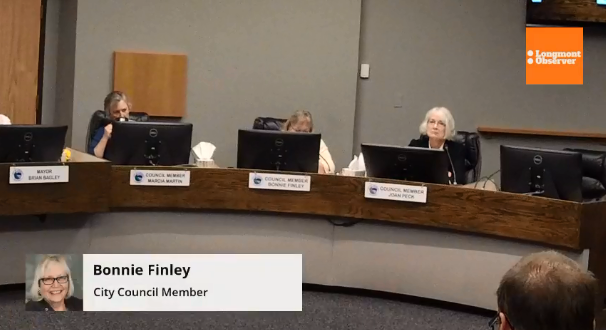This content was originally published by the Longmont Observer and is licensed under a Creative Commons license.
The Longmont City Council discovered, while reviewing 2019 budget priorities, that the Windy Gap Water Firming Project is going to cost significantly more than originally estimated. The Windy Gap Water Firming Project was approved as a ballot measure in November 2017.
According to Longmont city staff, the current numbers for the project indicate a cost at least 30% more than originally estimated.
Originally, the city was avoiding immediate rate increases and cash funding the project but are now planning on issuing bonds to pay for the project. This is to pay for 8,000 acre-feet of water, which was a reduction of the original 10,000 acre-feet proposed.
According to city staff: "A few things have changed since then including significant cost increases as we've gone through the design project to the tune of about 30% increase which overshadows that 20% volume reduction".
In addition, there are still legal issues that are being dealt with in the courts that are holding up construction until resolved. Western Slope entities are suing the project with the claim that the water belongs to them, not the Front Range. Resolution is expected to happen between 2019 and 2021.
Council Member Tim Waters expressed surprise when he saw these increases when he said, "My recollection of the decision of the council was to firm 10,000 acre-feet. I thought I saw three financing options, one of which was a bond for $36 Million dollars that was tied to the decision to firm 10,000 acre-feet with options for 8,000 and 6,000. I get costs go up, but had that council decided to firm 6,000 acre-feet there wouldn't have been a bond question"

The language in the bond question gave permission for up to $36M in bonds. His concern comes from the reason the city is selling bonds, which is that instead of paying for it with cash, existing revenues of the city and future rate increases, the cost of the project has gone up by 30% - so the city now has to sell bonds just to cover the additional costs.
The original estimate was $440 million for the entire project, of which Longmont has a $36 million portion and is now $575 million (a 30% increase) which indicates our cost for Windy Gap have gone from $36 million to almost $47 million. A $10 million dollar increase from estimates city staff made less than a year ago.
Council Member Waters then asked if it's now 30% more expensive than it was before, do we have any idea what the costs might be by the time the lawsuits settled, the design work finished and the construction actually starts; could it be double that?
This led to his final question which was "are we talking about using that complete capacity in terms of bonding because then this council is going to go back to talking about firming less than 8,000 acre-feet?" He went on to say that's something we ought to be talking about, that the public ought to understand and, given all the publicity, rhetoric and angst around going from 10,000 acre-feet to 8,000 acre-feet, we may be talking about 6,000 and spending as much as we were talking about spending for 10,000.
City staff's response was "That's definitely an option." City staff did add that it's unlikely that costs would double. The greatest risk to the project and its costs is the delay, likely due to legal issues.
The city itself isn't managing the project directly and they are frustrated by the process as well. City Manager Harold Dominguez said the thing to watch is the cost of concrete and steel which will have a big effect on final costs.
Council Member Waters than asked the rest of the council if he was the only one surprised by this. The rest of the council indicated that yes, they were also surprised.

Mayor Brian Bagley then commented that every acre-foot of water we let go has a line of people waiting to take control of it. He said this will be built and our neighbors would control it if we don't. City staff then commented that we get requests monthly to acquire the rights to that water.
The city staff then explained that most of the higher cost comes from a line item added to the budget by the group running the project - an 'Owners Increase'. This was the primary reason for the cost overruns. This is, effectively, a 'very significant' owner's contingency fund which is a buffer of funds that would cover any cost increases after the project has started and construction begun. This allows money to be set aside to cover likely future increases in costs. Why this fund wasn't considered before budgets were drawn up and commitments made was not commented on. City staff then went on to say that the owner's contingency fund should be more than sufficient to cover additional costs during construction. A doubling of costs was very unlikely.

Council Member Bonnie Finley then said, "I'm quite surprised that this council is going to take up how many acre-feet, I thought that was settled and the same people that voted for you guys voted for 10,000 acre-feet, we might want to keep that in mind".

Mayor Pro Tem Polly Christensen then asked what would happen to the excess funds left when the project is done. Would the money be returned to the city? City staff said a "big portion of that" would have to go back to the participants. About a year's worth of operation and maintenance funding would be retained, but the owner's contingency fund would be substantially more than that.
City staff also said there was a one year warranty period on the work.
Mayor Bagley then asked, "the dam is only guaranteed for a year?" Mayor Pro Tem Christensen pointed out that her dishwasher has a longer warranty than that.
Council Member Joan Peck then said "I think we need to get that RSVP going faster so that it's way before that year warranty is over." She also said she didn't completely understand the contingency bond; when city staff says "the owners authorize a contingency bond, who are the owners?"
City staff said the owners of the project are the participants managed through the Northern Colorado Water Conservancy District, who is technically on the hook. The contingency is $42 million dollars, to be covered by the participants, including Longmont and the other 5 cities. We also do not know the full cost of this project until it's actually bid. Then there is the actual cost of building it which could also be different. That final number will be brought back to the Council, with a recommendation, and why, for the city council to make a final decision on.
Council Member Tim Waters asked staff if there was a possibility of unspent money being returned to the city. Staff confirmed that contractually that is the case. In addition, Waters asked for staff to clarify the information that they would bring back to council for consideration, indicating that he would like additional information on how many acre feet Longmont can expect to get for the funds already approved. His concern is that as the costs of the project inflate, the risk of increasing water rates for residents goes up as well. He asked staff to provide data on the actual number of acre feet that Longmont can expect to obtain without additional costs and overruns.
Longmont city staff agreed to return with answers to the questions asked by council and asked council to keep in mind that the data they are seeing is still a model until the bid is made. The topic will be revisited once final cost numbers are obtained.


